

Why I Chose Sewing. Fabric. Essential sewing supplies. Sewing machine. Onsie Dress. Pillow Stuffing. 10 Minute Onesie Dress – Easiest Dress Ever. Hello, when you read this DIY you will be like “That’s it, I’m buying a sewing machine.”
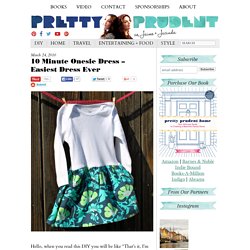
SO SIMPLE. It’s a onesie with a skirt around it, cute AND comfy: Find out how to make this 10 Minute Onesie Dress (with finished seams through no work of your own!) After the jump…10 Minute Onesie Dress 1. 2. 3. 3. 4. Sew together and finish the edges by serging, sewing with a zig zag or overlock stitch or cutting with pinking shears: Turn your skirt inside out to admire: 5. Turn it inside out and do the same thing on the inside: Now turn your skirt inside out and arrange the seam to one side: With your onesie right-side out, slip it headfirst through the skirt with the front facing up, like so: Unbutton the bottom of the onesie and flip it over the skirt. Sew all the way around with a 5/8″ seam. The QUICKEST Toddler Play Dress...you'll ever make! Can I tell you about another blogging friend, whom I totally adore?

I’m sure you’ve heard of her or seen her sewing creations online, many times before…….but Katy Dill is one clever woman. And she has 6 little subjects to sew for. 5 adorable girls….and a little book end toddler boy, Drummer! (You know that little guy is probably his sisters’ little dress up doll.) Anyway, Katy created a fun series, where she creates items for her children (and sometimes herself) which correspond with each letter of the alphabet. Sewing 101: zippered throw pillows. Next up in our learn-to-sew series: throw pillows!
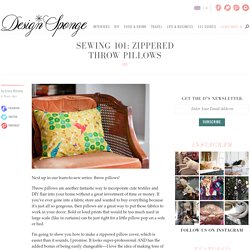
Throw pillows are another fantastic way to incorporate cute textiles and DIY flair into your home without a great investment of time or money. If you’ve ever gone into a fabric store and wanted to buy everything because it’s just all so gorgeous, then pillows are a great way to put those fabrics to work in your decor. Bold or loud prints that would be too much used in large scale (like in curtains) can be just right for a little pillow pop on a sofa or bed. I’m going to show you how to make a zippered pillow cover, which is easier than it sounds, I promise. It looks super-professional AND has the added bonus of being easily changeable—I love the idea of making tons of different pillow covers and just swapping them out whenever you want a little change in a room.
The best part? CLICK HERE for the full zippered throw pillow how-to after the jump! Sewing a Simple Baby Blanket. This baby blanket is super easy to make.
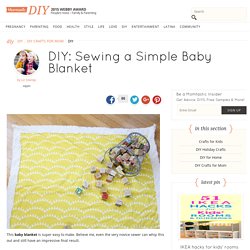
Believe me, even the very novice sewer can whip this out and still have an impressive final result. The trickiest part of those cute handmade baby blankets are those darn mitered corners. Here's a great tutorial that will help you create mitered corners on your soft baby blanket with a little cheating (shh! Don't tell your mom!). Materials: cotton fabric 36'' by 36'' fluffy cotton or poly/cotton like chenille. 41'' by 41''.
Start by cutting your two pieces of fabric. After cutting, lay the fluffy piece, right side down on the floor with the top cotton piece on top, right side up. Start about an inch or two from a corner. Continue down the side, pinching, folding, and securing with pins every couple of inches. Pillowcase Pattern // Easiest Way to Sew a Pillowcase. How to Replace a Needle in a Sewing Machine. Sewing Machine Needles & How to Choose Them. From Manda: When you become the owner of a sewing machine, you often sit down and read through the user manual, to familiarize yourself with which stitch to use for which fabrics and how to clean it, thread it and all the other general aspects of running a machine.
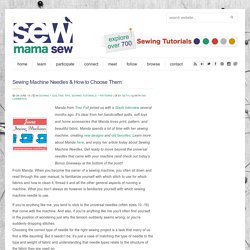
What you don’t always do however is familiarize yourself with which sewing machine needle to use. If you’re anything like me, you tend to stick to the universal needles (often sizes 10 -16) that come with the machine. And also, if you’re anything like me you’ll often find yourself in the position of wondering just why the tension suddenly seems wrong, or you’re suddenly dropping stitches. Choosing the correct type of needle for the right sewing project is a task that many of us find a little daunting. But it needn’t be, it’s just a case of matching the type of needle to the type and weight of fabric and understanding that needle types relate to the structure of the fabric they are used on.
Sewing 101: Choosing Fabric. We’re so excited to have Theresa Gonzalez, the instructor for our brand new Sewing 101 class, sharing her first post with all of you today!

She’ll be a regular fixture around these parts in the coming months, and we know you’ll appreciate her tips and insight into not only sewing, but design and decor as well. Read on for her thorough thoughts on fabric choice and a stellar discount code for her class! Timber & Leaf Collection by Sarah Watts, 100% Cotton When you’re just learning to sew, you want to brush up on the many types of fabrics out there — from cottons to wools to silks to synthetics. Understanding how these fabrics work differently will help you choose the best fabric for your project. Sewing Tips for Beginners & Pros. With so much excitement about learning to sew, improving skills and the new Sew Crazy Monthly Challenges, I thought it would be a good time to pull together a list of all sorts of sewing tips for beginners, pros and everyone in between.
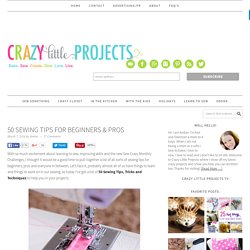
Sewing 101: Essentials. Part 1: What do you need to get started?
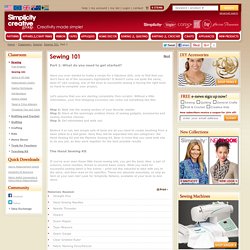
Have you ever started to make a recipe for a fabulous dish, only to find that you don't have all of the necessary ingredients? It doesn't come out quite the same, does it? Like cooking, one of the keys to successful sewing is having the right tools on hand to complete your project. Let's assume that you are starting completely from scratch.